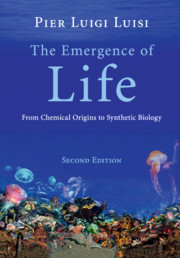Book contents
- Frontmatter
- Contents
- Acknowledgments
- Introduction
- Part I Approaches to the origin of life
- Part II What is life? The bio-logics of cellular life
- Part III Order and organization in biological systems
- Part IV The world of vesicles
- 11 The various types of surfactant aggregates
- 12 Vesicle reactivity and transformations
- 13 Biochemistry and molecular biology in vesicles
- Part V Towards the synthetic biology of minimal cells
- As a way of conclusion
- Appendix The open questions about the origin of life
- References
- Names index
- Subject index
11 - The various types of surfactant aggregates
from Part IV - The world of vesicles
Published online by Cambridge University Press: 05 September 2016
- Frontmatter
- Contents
- Acknowledgments
- Introduction
- Part I Approaches to the origin of life
- Part II What is life? The bio-logics of cellular life
- Part III Order and organization in biological systems
- Part IV The world of vesicles
- 11 The various types of surfactant aggregates
- 12 Vesicle reactivity and transformations
- 13 Biochemistry and molecular biology in vesicles
- Part V Towards the synthetic biology of minimal cells
- As a way of conclusion
- Appendix The open questions about the origin of life
- References
- Names index
- Subject index
Summary
Introduction
In the previous two chapters, we have seen the general principles of self-organization and emergence based on examples from the most important classes of biopolymers, proteins, and nucleic acids. We have also seen, rapidly, a quite different class of aggregates, those formed by amphiphilic molecules and micelles and vesicles. In this chapter, we will consider these surfactant aggregates in more detail.
The importance is twofold, in qualitative as well as quantitative terms. On the one hand, biological amphiphiles like lipids and phospholipids are important constituents of cell membranes in the entire living world. If you consider that each of us has c. 100 billion cells, and each cell may contain an average of 109–1010 phospholipid molecules, you get a quick idea of the relevance of such compounds.
On the other hand, in a quite different perspective, surfactant molecules are extremely important for technological applications – from the pharma industry to cosmetics (soaps, cosmetics and the like) and to the heavy industry – in petrol extraction and mechanical washings. In fact, the term surfactant indicates a basic property: the capability to reduce the surface tension (or interfacial tension) between two liquids or between a liquid and a solid. They may thus act as detergents, wetting agents, emulsifiers, foaming agents, and dispersants (Falbe, 1987). The world production amounts to several million tons per year, and roughly two-thirds of this is in the form of anionic surfactants, followed by non-ionic surfactants, with a small share of cationic surfactants.
For the present discussion, amphiphiles have to do with one of our main concepts, that of “compartment” and (if this word exists) “compartmentation.” This is, of course, very relevant for biology at large, and to start with, it is then proper to compare the various kinds of compartments, such as those formed by micelles, reverse micelles, cubic phases, and vesicles. This will be useful for discussing the biochemical reactions in vesicles, which will be dealt with later on in this chapter.
General properties of surfactant aggregates
We have already seen, talking about self-organization, how and why amphiphilic molecules tend to form aggregates such as micelles, vesicles, and other organized structures.
Figure 11.1 illustrates the phase diagram obtained for CTAB (cetyl trimethyl ammonium bromide, a surfactant). In this example, the type of aggregate that can be obtained is determined by the relative concentration of the three (in this case) components.
- Type
- Chapter
- Information
- The Emergence of LifeFrom Chemical Origins to Synthetic Biology, pp. 265 - 296Publisher: Cambridge University PressPrint publication year: 2016



